
Try Amazon Audible Premium Plus and Get Up to Two Free Audiobooks
Ghaznavid or Saljuq Glass Medallion.

Picture source: Khalili collection GLS 608


Iran, Afghanistan or Central Asia
12th century AD
turquoise-blue glass, moulded and stamped in relief
9.1 cm (diameter)
GLS 608
Khalili collection
The medallion shows a mounted huntsman, facing backwards with a falcon on his wrist. Below, a long-tailed hound pursues a hare, also with its head turned. The horse's tail is knotted and its trappings and the saddle cloth are elaborately decorated with beading.
Relief-stamped coloured glass medallions were excavated in the ruins of a l3th century palace at Termez on the Oxus, close to the Afghan-Uzbek frontier. Some have inscriptions dating them to late Ghaznavid period (mid 12th century). They have also been reported at Ghazna in Afghanistan and may well have decorated other Ghaznavid palaces, for example at Nishapur. Too small and insufficiently translucent for window-panes, they were probably used to crown a stucco dado, where their remarkable detail could best be appreciated.
Source: p127, The arts of Islam. Masterpieces from the Khalili collection, J.M. Rogers. London (Thames & Hudson) 2010